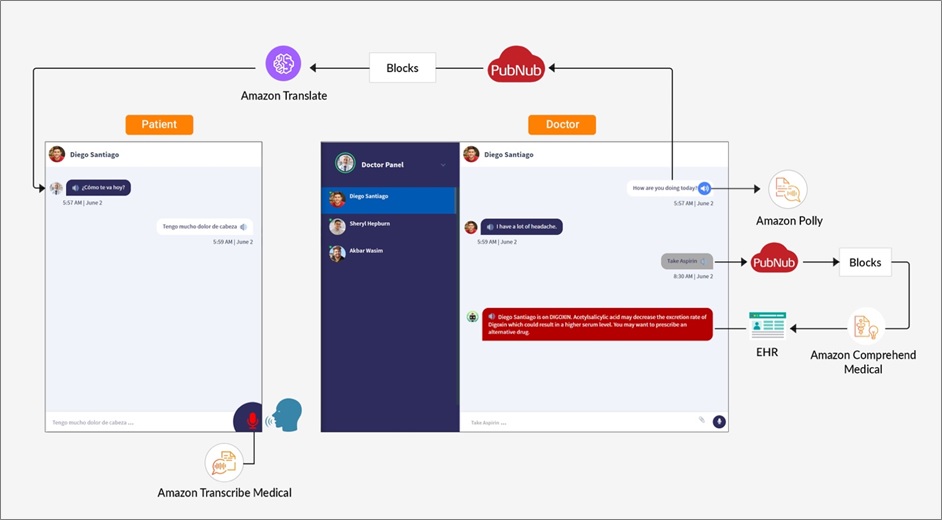Amazon Web Services Feed
How SF Medic Provides Real-Time Clinical Decision Support Using AWS Machine Learning Services

By Kabir Chandhoke, Chief Operating Officer at SourceFuse
By Vaidant Singh, Marketing Director at SourceFuse
 |
 |
The healthcare industry is experiencing a global shortage of doctors, nurses, and other healthcare professionals.
The World Health Organization (WHO) notes that more than 45 percent of WHO Member States have less than one physician per 1,000 population. This shortage leads to consistent demand being placed on the healthcare industry, particularly during times of global pandemic.
Telemedicine, which provides primary healthcare services to patients through remote connectivity, is one approach for addressing this challenge. Aimed at improving patient outcomes and focusing patient-provider interactions, telemedicine can increase access to healthcare by removing limitations such as transportation, distance to clinic, and variable financial expenses.
Telemedicine applications, however, are often dependent on technological barriers—access to the internet, high-bandwidth utilization, and technology costs, to name a few. Lack of user-confidence in the applications is also an issue.
If a patient in a rural area wants to connect with a provider, for example, both patient and provider would need steady internet connections and handheld devices with functioning cameras to effectively communicate during their interaction. Some telemedicine consultations fail in simply establishing a connection between patient and provider.
SourceFuse Technologies is an AWS Partner Network (APN) Advanced Consulting Partner with multiple AWS Competencies and a niche focus on healthcare and life sciences industries. Recently, we developed an easy-to-use and secure telemedicine application called SF Medic that can be adopted by hospitals, clinics, and even single-physician practices.
In this post, we will discuss how SF Medic provides smart and language-independent assistance to doctors, as well as personalized health consultation for patients with an enhanced layer of security and compliance.
Introducing SF Medic
SF Medic, built on Amazon Web Services (AWS), is designed to replace non-serious case—up to Grade 3 of Adverse Events—visits like general physician visits, regular health check-ups, and general medical inquiries. It helps overcome telemedicine’s shortcomings related to internet access, high-bandwidth requirements, and technology costs.
SF Medic is typically integrated with a healthcare facility’s existing electronic health records (EHR) solution to provide patients the right context for their interaction.
The SF Medic solution provides:
- Real-time clinical decision support using AWS artificial intelligence (AI), machine learning (ML), and natural language processing (NLP).
- Real-time language translation using Amazon Translate.
- Asynchronous text or voice messaging is the preferred mode of communication between patient and provider.
How it Works
Once a patient has booked an appointment with their provider, they start a private interaction (in their preferred language) using the SF Medic mobile solution on their device.
We use the AWS Shared Responsibility Model for security, which is critical when protecting patient data. The EHR patient data contains names, dates of birth, addresses, phone numbers, places of work and positions, IDs, card numbers, and information related to medical and social insurance. A security breach of such information can lead to complete identity theft, patient embarrassment, and legal consequences for the provider.
With SF Medic, the patient and provider have the option of interacting using text-based or voice snippet features, or a combination of both modes. Each message exchanged (text or voice) is translated in real-time and presented as both text and voice message. This way, the patient and provider can read and/or listen to the translated message with just the click of a button.
During the interaction, SF Medic processes all patient-provider messages and triggers Clinical Decision Support Intervention(s) in case the:
- Physician recommends a drug for which the patient has a known allergy.
- Physician recommends a drug that has a known contraindication to a drug prescribed in the patient’s current treatment cycle.
Watch the Video (1:35)
Tech Stack
SF Medic is designed for hospitals, specialty clinics, and healthcare startups focused on patient recovery journey and care management. It uses ML and data streaming technology to facilitate doctor-patient text or asynchronous voice-based interaction anywhere across the globe.
REST API provides SF Medic the ability to integrate with electronic health records to pull Protected Health Information (PHI), including medication and patient history. With this information, SF Medic supports the provider with real-time clinical decision support alerts, such as potential drug contraindications using Amazon Comprehend Medical, Amazon Transcribe Medical, and Amazon Translate.
The clinical decision support alerts enhance the provider’s decision making, reducing the risk of human error and optimizing patient safety. All PHI that flows through SF Medic uses HIPAA-eligible AWS services, and SF Medic implements the authentication, authorization, and encryption requirements as part of a HIPAA-compliant product.
AWS and PubNub are the primary technology platforms used to build SF Medic. PubNub is an APN Advanced Technology Partner and has a real-time publish/subscribe messaging API, built on a global data stream network made up of a replicated network with multiple points of presence. PubNub is also a HIPAA-compliant service.
With SF Medic, PubNub is used alongside AWS for bi-directional transport of real-time messages between doctor and patient, and to trigger AWS services such as Amazon Translate, Amazon Comprehend Medical, Amazon Transcribe, and Amazon Polly. These features make PubNub an ideal choice for building the communication backbone for Medic.
Figure 1 – Technology workflow behind SF Medic’s doctor assistance.
How SF Medic Leverages AWS AI and ML Services
Amazon Comprehend Medical
Amazon Comprehend Medical is an NLP engine that can be used to identify medical terminology in text. When a physician sends a text message in SF Medic, it is first sent to Amazon Comprehend Medical, which extracts medical terms such as medications and dosages.
The medication name is then looked up on the patient’s EHR record. If a match is found, the physician is shown a clinical decision support intervention and their message is blocked for the patient’s safety.
Amazon Translate
Amazon Translate is a neural language translation service. It uses deep learning models to deliver more accurate and natural-sounding translation than traditional statistical and rule-based translation algorithms.
During the SF Medic interaction between patient and physician, this service translates both text and transcribed voice message in real-time to facilitate the conversation.
Amazon Transcribe Medical
Amazon Transcribe Medical is a machine learning service that makes it easy to create accurate transcriptions from medical consultations between patients and providers.
Leveraging this service, the medical and pharmacological terms used in physician dictated notes, consultations, and telemedicine are automatically converted from speech to text for use in clinical documentation applications.
Amazon Polly
Amazon Polly turns text into lifelike speech, allowing you to create applications that talk, and build entirely new categories of speech-enabled products. Using this service, with a click of a button, SF Medic allows the user to listen to the text message received.
Getting Started with SF Medic
SF Medic is available as a bolt-on product that integrates with a customer’s system such as EHR, Customer Relationship Management (CRM), or Hospital Information Management System (HIMS).
The SourceFuse team of AWS-certified engineers deploy SF Medic on the customer’s AWS and PubNub accounts, performing the necessary integration and customization of the solution as a statement of work (SOW).
Once the system is up and running, there are no recurring license fees to be paid. The customer only pays for the AWS and PubNub services which are pay-per-use. Deploying the solution on the customer’s AWS account ensures security and compliance policies are met internally, and does not add any onboarding overhead.
Customers can decide to offer SF Medic either as a standalone tool, or add the Clinical Decision Support (CDS) and translation capabilities to an existing chat interface. In both scenarios, SourceFuse works with the customer and does a deep dive into its use case and existing technology landscape.
As part of the SOW, SourceFuse provides maintenance and managed services to keep SF Medic running smoothly for a minimum 12-month period.
Conclusion
Telemedicine solutions like SF Medic can improve the continuum-of-care cycle and cost-effectiveness of healthcare services. It’s especially beneficial for underserved communities in rural or remote areas, limited by the dependency on technology and high-bandwidth internet.
Telemedicine focuses on being a technology solution, rather than a technology driver solution. The rue benefits of telemedicine can only be achieved when we improve the time utilization of providers and convenience for patients.
SourceFuse has delivered more than 600 AWS implementations that boost efficiency, ensure compliance, deliver actionable insights, and lower total cost of ownership (TCO).
We invite you to learn more about SF Medic and schedule a demo to get started.
The content and opinions in this blog are those of the third party author and AWS is not responsible for the content or accuracy of this post.
SourceFuse – APN Partner Spotlight
SourceFuse is an AWS Competency Partner with a niche focus on healthcare and life sciences industries. They recently developed an easy-to-use and secure telemedicine application called SF Medic that can be adopted by hospitals, clinics, and even single-physician practices.
Contact SourceFuse | Solution Overview
*Already worked with SourceFuse? Rate this Partner
*To review an APN Partner, you must be an AWS customer that has worked with them directly on a project.
